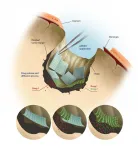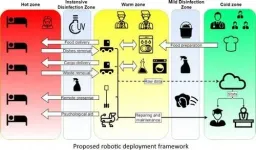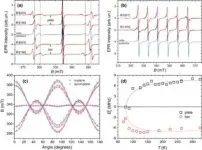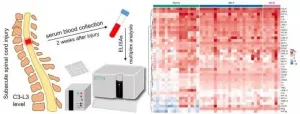(Press-News.org) A simple dietary supplement reduces behavioral symptoms in mice with a genetic mutation that causes schizophrenia. After additional experiments, including visualizing the fluorescently stained dancing edge of immature brain cells, researchers concluded that the supplement likely protects proteins that build neurons' cellular skeletons.
The supplement betaine was first isolated from sugar beets and is often associated with sweetness or umami flavor. Healthy levels of betaine come from both external food sources and internal synthesis in the body. Betaine supplements are already used clinically to treat the metabolic disease homocystinuria.
"I don't encourage anyone to take betaine for no reason, if a doctor has not recommended it. But, we know this drug is already used clinically, so repurposing it to treat schizophrenia should be safe," said Project Professor Nobutaka Hirokawa, M.D., Ph.D., from the University of Tokyo Graduate School of Medicine who led the recent research project. Hirokawa has been a member of the Japan Academy, a national honorary organization recognizing scientific achievement, since 2004 and received a Person of Cultural Merit award from the Japanese government in 2013.
Schizophrenia is estimated to affect about 1 in 100 people globally and is one of the top 15 leading causes of disability worldwide.
"There are treatments for schizophrenia, but they have side effects and unfortunately there is still no effective drug for patients to take that we can explain biochemically why it works," explained Hirokawa.
Genetic studies of people diagnosed with schizophrenia have found possible links between the disease and variations in the kinesin family 3b (kif3b) gene as well as another gene involved in the body's internal synthesis of betaine.
Hirokawa and his lab members have categorized all 45 members of the kinesin superfamily of genes in mammals, most of which encode motor proteins that move materials throughout the cell. Normally, the KIF3B protein links together with another kinesin superfamily protein and transports cargo throughout a neuron by traveling up and down the cell's skeleton.
Mice used in the recent research had only one functional copy of the kif3b gene and are often used as an animal model of schizophrenia. These mice avoid social interactions and show the same weak response as human patients with schizophrenia in a test called prepulse inhibition, which measures how startled they are by a sudden, loud sound preceded by a quieter sound.
Kif3b mutant mice raised on a diet supplemented with three times the normal amount of betaine had normal behavior, indicating that betaine supplements could treat schizophrenia symptoms.
To figure out why betaine had this effect on mice, researchers grew nerve cells with the kif3b mutation in the laboratory and added fluorescent labels so they could watch the cellular skeleton take shape.
The shape of a healthy neuron is reminiscent of a tree: a cell body surrounded by branches, the dendrites, attached to a long trunk, the axon. Kif3b mutant neurons grown in the lab have an unusual, hyperbranched structure with too many dendrites. Similar hyperbranched neurons are also seen in brain samples donated by people with schizophrenia, regardless of what treatments or medications they took while they were alive.
During healthy neuron development, the main body of the cell fills with a skeleton component called tubulin. Meanwhile, the front growth cone of the cell builds outwards in a spiky, erratic dance due to the movements of another skeleton component called filamentous actin. In kif3b mutants, this dancing movement, which experts refer to as lamellipodial dynamics, is noticeably reduced and the division between tubulin and actin is blurred.
The actin in a neuron's cellular skeleton is assembled in part by another protein called CRMP2. Chemical analyses of the brains of kif3b mutant mice and human schizophrenia patients reveal significant chemical damage to CRMP2, which causes the proteins to clump together.
Betaine is known to prevent the type of chemical damage, carbonyl stress, that causes this CRMP2 dysfunction.
"In postmortem brains of schizophrenia patients, CRMP2 is the protein in the brain with the most carbonyl stress. Betaine likely eliminates the carbonyl stress portion of the schizophrenia equation," said Hirokawa.
By protecting CRMP2 from damage, betaine treatment allows kif3b mutant neurons to build proper structures. With a structurally sound skeleton to navigate, the remaining functional KIF3B protein can shuttle cargo around the cell. Other test tube experiments revealed that KIF3B and CRMP2 can bind together, but their exact relationship remains unclear.
"We know that the amount of betaine decreases in schizophrenia patients' brains, so this study strongly suggests betaine could be therapeutic for at least some kinds of schizophrenia," said Hirokawa.
The UTokyo research team is planning future collaborations with pharmaceutical companies and clinical studies of betaine supplements as a treatment for schizophrenia.
INFORMATION:
This research is a peer-reviewed experimental study in mice and human cells published in the journal Cell Reports.
Research Publication
Shogo Yoshihara, Xuguang Jiang, Momo Morikawa, Tadayuki Ogawa, Sotaro Ichinose, Hirooki Yabe, Akiyoshi Kakita, Manabu Toyoshima, Yasuto Kunii, Takeo Yoshikawa, Yosuke Tanaka, Nobutaka Hirokawa. 13 April 2021. Betaine ameliorates schizophrenic traits by functionally compensating for KIF3-based CRMP2 transport. Cell Reports. DOI: 10.1016/j.celrep.2021.108971
https://doi.org/10.1016/j.celrep.2021.108971
Related Links
Hirokawa Lab: http://cb.m.u-tokyo.ac.jp/index.html
Graduate School of Medicine: http://www.m.u-tokyo.ac.jp/english/index.html
Research Contact
Project Professor Nobutaka Hirokawa, M.D., Ph.D.
Department of Cell Biology and Anatomy, Graduate School of Medicine, The University of
Tokyo, 7-3-1 Hongo, Bunkyo-ku, Tokyo 133-8654, JAPAN
Tel: +81-03-5841-3336
Email: hirokawa@m.u-tokyo.ac.jp
Press Officer Contact
Ms. Caitlin Devor
Division for Strategic Public Relations, The University of Tokyo, 7-3-1 Hongo, Bunkyo-ku, Tokyo 133-8654, JAPAN
Tel: +81-080-9707-8178
Email: press-releases.adm@gs.mail.u-tokyo.ac.jp
About the University of Tokyo
The University of Tokyo is Japan's leading university and one of the world's top research universities. The vast research output of some 6,000 researchers is published in the world's top journals across the arts and sciences. Our vibrant student body of around 15,000 undergraduate and 15,000 graduate students includes over 4,000 international students. Find out more at http://www.u-tokyo.ac.jp/en/ or follow us on Twitter at @UTokyo_News_en.
Up to 25 percent of global food production is lost annually due to insects, primarily beetles. For the past 500 million years, beetles have successfully spread and adapted to life around the globe and now account for one of every five animal species on Earth. Yet as far back as ancient Egypt, these tough little bugs have invaded granaries and vexed us humans by destroying our crops.
As a result, food production and an abundant use of pesticides now go hand in hand. A large share of these pesticides damage biodiversity, the environment and human health. As various pesticides are phased out, new solutions are required to target and eradicate pests without harming humans or beneficial ...
Atlantic bluefin tuna have returned to UK waters and can once again be seen during the summer and autumn months.
Their numbers appear to be increasing, following a long period of absence linked to population decline, according to research led by Cefas and the University of Exeter.
Marine scientists in the UK and Ireland have analysed multiple datasets, spanning a 16-year period, to document the increase in bluefin, which arrive into the waters of the Celtic Seas and off South West England, the Scilly Isles, and North West Ireland to feed in late summer and autumn.
The research is part of the Defra-funded "Thunnus UK" research project. ...
Stroke risk for patients with traumatic brain injuries is at its highest in the four months following injury and remains significant for up to five years post-injury, finds a new systematic review led by a team at the University of Birmingham.
Traumatic brain injury (TBI) is a global health problem affecting over 60 million people a year worldwide. Incidences of TBI are rising due to a range of factors including increased falls in the elderly, military conflict, sports injuries and road traffic accidents. However, advances in critical care and imaging have led to a reduction in TBI-related mortality.
Previous studies have associated TBI with a long-term risk of neurological diseases including dementia, ...
There are many variants of "goblet cells" in the intestines and they seem to have different functions, according to a new study from the University of Gothenburg. The study indicates that defects in goblet cells of a particular type may be a factor contributing to ulcerative colitis, an inflammatory bowel disease.
The entire inside of our intestines is covered by a thin layer of mucus that protects the fragile mucous membrane (mucosa) from bacteria and other microorganisms. If the microorganisms repeatedly come into contact with the intestinal mucosa, inflammation and even cell changes may result. These increase the risk of intestinal cancer. In a healthy colon, the mucus layer is up to a millimeter ...
Genova (Italy), 16th April 2021 - A micro-sized polymeric net wrapping around brain tumors, just like a fishing net around a shoal of fish: this is the microMESH, a new nanomedicine device capable to conform around the surface of tumor masses and efficiently deliver drugs. It has been described by the researchers of the IIT - Istituto Italiano di Tecnologia (Italian Institute of Technology) in Nature Nanotechnology. The new biomedical implant has been validated in preclinical studies that demonstrate its effectiveness for the treatment of glioblastoma multiforme.
This work has been carried out by the group of Prof. Paolo Decuzzi, head of the IIT Laboratory of Nanotechnology ...
The prevalence of intellectual disabilities, which means difficulties with learning and understanding new things, is roughly 1-2% in the population. People with a severe intellectual disability need help from others in daily activities throughout their lives.
Such disabilities can be caused by genetic changes or external factors. According to estimates, roughly 2,500 genes underlie intellectual disability, of which approximately half remain unidentified.
In recent years, the diagnostics for intellectual disabilities have improved thanks to advancements in techniques that make it possible ...
Language is one of the most notable abilities humans have. It allows us to express complex meanings and transmit knowledge from generation to generation. An important question in human biology is how this ability ended up being developed, and researchers from the universities of Barcelona, Cologne and Tokyo have treated this issue in a recent article.
Published in the journal Trends in Cognitive Sciences, the article counts on the participation of the experts from the Institute of Complex Systems of the UB (UBICS) Thomas O'Rourke and Pedro Tiago Martins, led by Cedric Boeckx, ICREA research professor at the Faculty of Philology ...
In December 2019, a new viral infection was detected in Wuhan, China. On January 30, 2020, the World Health Organization declared the outbreak a public health emergency of international concern, and on March 11, the COVID-19 pandemic. In light of the danger that the infection poses to human personnel, the idea to utilize automation in hospitals is one of the natural solutions in healthcare.
Among the paper's five co-authors, four are working in robotics and one is an expert in medicine. The paper presents a new concept of an infectious hospital that may become a worldwide standard in the future. The idea of this appeared while the authors ...
While studying strontium titanate with electron paramagnetic resonance, a team from KFU's Center for Quantum Technology has found that the shape of a specimen of strontium titanate influences its internal symmetry. The research was co-conducted by the Ioffe Institute of Physics and Technology (Russia) and the Institute of Physics of the Czech Academy of Sciences.
At room temperature, SrTiO3 is a crystal with high cubic symmetry, that is, the lattice of strontium titanate, like bricks, is composed of unit cells, each of which is a regular cube. However, the researchers showed the picture is a bit more nuanced. In ...
The research is conducted by Kazan University's Open Lab Gene and Cell Technologies (Center for Precision and Regenerative Medicine, Institute of Fundamental Medicine and Biology) and Republic Clinical Hospital of Kazan. Lead Research Associate Yana Mukhamedshina serves as project head.
Spinal cord injury mechanisms include primary and secondary injury factors. Primary injury is mechanical damage to the nervous tissue and vasculature with immediate cell death and hemorrhage. Secondary damage leads to significant destructive changes in the nervous tissue due to the development of excitotoxicity, death ...





